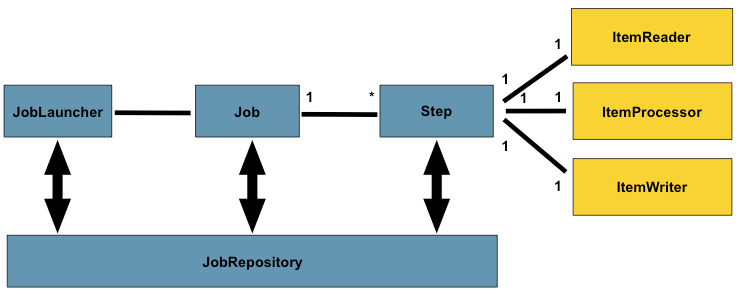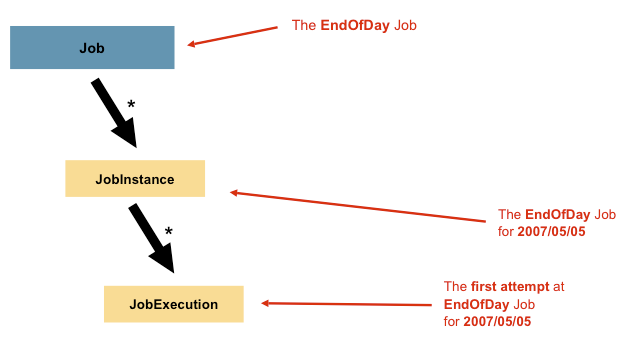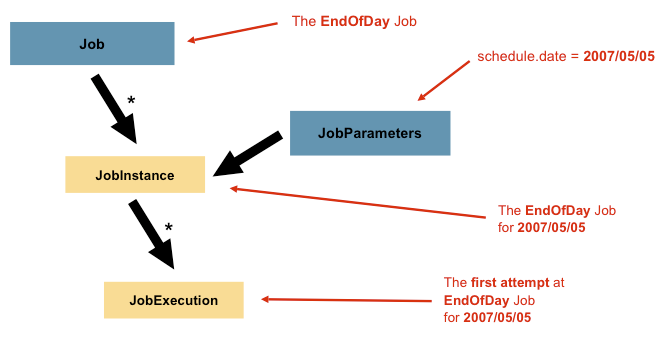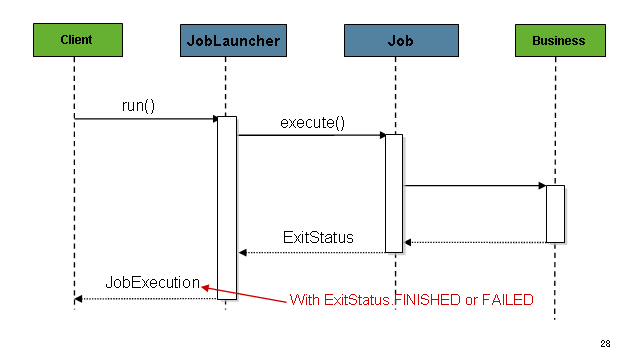批处理领域语言
下图是批处理整体框架, spring Batch提供了层、组件和技术服务的物理实现,这些层、组件和技术服务通常存在于健壮的、可维护的系统中,用于创建从简单到复杂的批处理应用程序,其基础设施和扩展用于处理非常复杂的处理需求。

黄色部分代表了Spring-batch的核心组件,每一个Job有一或者多个步骤(Step),每个Step都有一个ItemReader、ItemWriter和一个ItemProcessor。而启动一个Job需要一个Job执行器(JobLauncher),并且需要存储有关当前Job进程中的一些元数据(JobRepository)。
1. Job
Job是封装整个批处理过程的实体。在Spring-Batch中,一个Job可以简单看做多个Step的容器。 它将逻辑上属于一个流的多个步骤组合在一起,并允许配置所有步骤的全局属性,例如可重新启动性。

一个Job可以通过XMl、或者java配置的方式进行配置。主要包含:
- job的名称
- Step的定义和顺序
- Job是否可以restart
Job接口的默认实现有SimpleJob,提供了一些默认实现。使用Java 的配置方式
1 |
|
2. JobInstance
代表是一个Job真正运行的实例。每个Job可以执行多次,每个JobInstance都与一个JobParameter绑定。
JobInstance的定义与要加载的数据完全无关。完全由ItemReader实现决定如何加载数据。
使用相同的JobInstance决定是否使用以前执行的“状态”(即ExecutionContext,)。使用一个新的JobInstance意味着“从头开始”,而使用一个现有的实例通常意味着“从你离开的地方开始”。
3. JobParameters
那么如何区分JobInstance之间的不同呢?答案就是JobParameters。JobParameters作为一系列的启动参数用于启动一个批处理任务。

假如一个Job启动了两个实例: 一个在1月1号启动,一个在1月2号启动,他们各自有自己的JobParameters。那么约定:JobInstance = Job+identifying JobParameters 。这允许开发人员有效地控制JobInstance的定义方式,因为他们可以控制传入的参数。
4. JobExecution
JobExecution表示一个Job运行中的技术概念。 执行可能以失败或成功结束,但与给定执行对应的JobInstance不被认为是完成的,除非执行成功完成 。
以前面描述的EndOfDay 的Job为例,考虑在第一次运行时失败的JobInstance。如果使用与第一次运行(01-01-2017)相同的标识作业参数再次运行它,则会创建一个新的JobExecution。但是,仍然只有一个JobInstance。
一个Job定义了任务是怎么样的以及是怎么被执行的, 然而,jobeexecution是运行期间实际发生情况的主要存储机制,它包含许多必须控制和持久化的属性。
| Property | Definition |
|---|---|
| Status | A BatchStatus object that indicates the status of the execution. While running, it is BatchStatus#STARTED. If it fails, it is BatchStatus#FAILED. If it finishes successfully, it is BatchStatus#COMPLETED |
| startTime | A java.util.Date representing the current system time when the execution was started. This field is empty if the job has yet to start. |
| endTime | A java.util.Date representing the current system time when the execution finished, regardless of whether or not it was successful. The field is empty if the job has yet to finish. |
| exitStatus | The ExitStatus, indicating the result of the run. It is most important, because it contains an exit code that is returned to the caller. See chapter 5 for more details. The field is empty if the job has yet to finish. |
| createTime | A java.util.Date representing the current system time when the JobExecution was first persisted. The job may not have been started yet (and thus has no start time), but it always has a createTime, which is required by the framework for managing job level ExecutionContexts. |
| lastUpdated | A java.util.Date representing the last time a JobExecution was persisted. This field is empty if the job has yet to start. |
| executionContext | The “property bag” containing any user data that needs to be persisted between executions. |
| failureExceptions | The list of exceptions encountered during the execution of a Job. These can be useful if more than one exception is encountered during the failure of a Job. |
这些属性是持久化的,因此可以完全确定一个execution的执行状态。
5. Step
它封装了批处理作业的一个独立的顺序阶段。 每个Job都完全由一个或多个步骤(Step)组成。一个步骤包含定义和控制实际批处理所需的所有信息。
6. StepExecution
每次运行Step时都会创建一个新的StepExecution,类似于jobeexecution。但是,如果一个步骤执行失败是因为它之前的步骤失败,则不会为它持久执行。 只有当其Step实际启动时,才会创建StepExecution。
| Property | Definition |
|---|---|
| Status | A BatchStatus object that indicates the status of the execution. While running, the status is BatchStatus.STARTED. If it fails, the status is BatchStatus.FAILED. If it finishes successfully, the status is BatchStatus.COMPLETED. |
| startTime | A java.util.Date representing the current system time when the execution was started. This field is empty if the step has yet to start. |
| endTime | A java.util.Date representing the current system time when the execution finished, regardless of whether or not it was successful. This field is empty if the step has yet to exit. |
| exitStatus | The ExitStatus indicating the result of the execution. It is most important, because it contains an exit code that is returned to the caller. See chapter 5 for more details. This field is empty if the job has yet to exit. |
| executionContext | The “property bag” containing any user data that needs to be persisted between executions. |
| readCount | The number of items that have been successfully read. |
| writeCount | The number of items that have been successfully written. |
| commitCount | The number of transactions that have been committed for this execution. |
| rollbackCount | The number of times the business transaction controlled by the Step has been rolled back. |
| readSkipCount | The number of times read has failed, resulting in a skipped item. |
| processSkipCount | The number of times process has failed, resulting in a skipped item. |
| filterCount | The number of items that have been ‘filtered’ by the ItemProcessor. |
| writeSkipCount | The number of times write has failed, resulting in a skipped item. |
7. ExecutionContext
ExecutionContext代表一系列key-value的数据map。 好的使用例子是方便重新启动。以平面文件输入为例,在处理单个行时,框架定期在提交点持久化ExecutionContext。
8. JobRepository
JobRepository是上述概念的持久化机制。提供了一些CRUD的操作、 当Job第一次启动时,从存储库中获得jobeexecution,并且在执行过程中,通过将StepExecution和jobeexecution实现传递给存储库来持久化它们。
9. JobLauncher
Job 执行器、
10. Item Reader
ItemReader是一种抽象,表示对Step的输入的检索,每次一项。当ItemReader耗尽了它所能提供的项时,它将通过返回null来表示。关于ItemReader接口及其各种实现的更多细节可以在Readers和writer中找到。
11. Item Writer
它表示一个步骤的输出,一次一批或一组项目。通常,ItemWriter不知道它接下来应该接收的输入,只知道在当前调用中传递的项。
12. Item Processor
每一条数据的处理逻辑。 如果在处理该项时确定该项无效,则返回null表示不应写入该项。
配置
执行批处理作业时的一个关键问题是重新启动作业时的行为。如果特定JobInstance的jobeexecute已经存在,则启动Job被认为是“重新启动”
Restartability属性
将restarttable设置为false意味着此Job不支持再次启动。重新启动不可重新启动的作业将引发JobRestartException异常
EnableBatchProcessing
@EnableBatchProcessing提供了用于构建批处理任务的基本配置。在这个基本配置中,除了许多可用于自动连接的bean之外,还创建了一个StepScope实例
JobRepository: bean name “jobRepository”JobLauncher: bean name “jobLauncher”JobRegistry: bean name “jobRegistry”PlatformTransactionManager: bean name “transactionManager”JobBuilderFactory: bean name “jobBuilders”StepBuilderFactory: bean name “stepBuilders”
改变存储机制
可能不需要将Job的状态存储在数据库中, 出于这个原因,Spring批处理提供了作业存储库的内存中的Map版本。
1 | // This would reside in your BatchConfigurer implementation |
请注意,内存中的存储库是不稳定的,因此不允许在JVM实例之间重新启动。它也不能保证同时启动两个具有相同参数的作业实例,并且不适合在多线程作业或本地分区Step中使用。因此,只要需要这些特性,就使用存储库的数据库版本。
确实需要定义事务管理器,因为存储库中存在回滚语义,而且业务逻辑可能仍然是事务性的(例如RDBMS访问)。出于测试目的,许多人发现ResourcelessTransactionManager很有用。
但是MapJobRepositoryFactoryBean已经过时了,将会在Spring-Batch 5.x版本中移除。因此如果想要基于内存的操作,那么可以配置一个本地的数据库,如H2, Apache Derby or HSQLDB 等,
1 |
|
配置数据源后需要结合createJobRepository来设置。
配置Configuring a JobLauncher
获得jobeexecution后,将它传递给Job的execute方法,最终将jobeexecution返回给调用者,如下图所示

1 |
|


